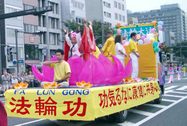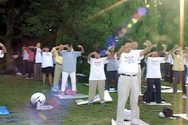When speaking of Japan, people often think of Mount Fuji, Toyota, Sony and so on. 126 million people live in this country of merely 145 thousand square miles. The Japanese people have created many famous products and made Japan the second major economic global power. It is convenient to live in Japan-- the standard of living is very developed, so Japanese people often have difficulty adapting to life in other countries.
Japan consists of four large islands: Hokkaido, Honshu, Shikoku and Kyushu, and 4,000 other small islands. The climate of Japan is predominantly temperate but varies greatly from north to south. Sakura, or the blossoming ornamental cherry tree, is the ubiquitous symbol of Japan, and is represented on all manner of consumer goods, including kimonos, stationery, and dishware.
Falun Dafa Takes Root in Japan
In August 1997, a dozen Falun Gong practitioners founded the first exercise site in a park in Tokyo. Since then, Falun Dafa has been rooted in this country. On September 30th, 1997, practitioners bought a page in a Chinese newspaper to introduce Falun Gong. Later, practitioners published their cultivation experiences and their contact phone numbers in this newspaper. Many people who have a predestined relationship came to learn the exercises. The number of practitioners in Japan has increased fast.
 |
| Group exercises (Hiroshima, August, 2000) |
In August 1998, 150 practitioners from Japan went to Singapore to attend the Falun Gong Cultivation Experience Sharing Conference. In the conference, Master Li gave a five-hour lecture. After the conference, Master Li met with practitioners from Japan and gave a two-hour lecture to them. In March 1999, the Japanese translation of Zhuan Falun was published by a publishing house in Kyoto. On July 10th, 1999, the Japanese translation of China Falun Gong was also published.
In July 1999, the first Japan Falun Dafa Cultivation Experience Sharing Conference was held in Yokohama. The number of exercise sites in Japan reached 30. Now, there are almost 50 exercise sites in Japan, There are several hundred Japanese practitioners in the Kumamoto area.
Media Report on Falun Gong, Making Falun Gong Well-known
 |
| Kyoto, September, 2004 |
The first report about Falun Gong by the Japanese media was an article in Nihon Keizai Shimbun, one of the biggest newspapers in Japan and was published on February 25th, 1999. The article, entitled "Chinese Qigong is Hot; More than 60 Million People Practise," quoted the introduction of Falun Gong from the Hong Kong newspaper, Singtao Daily .
The peaceful appeal on "April 25", 1999 drew a lot of attention from the media. All the big media outlets in Japan reported this event. Practitioners, then, prepared the Japanese translation of Zhuan Falun and introduced Falun Gong to the media. On July 10th, the newspaper Sankei published an article, entitled, "The First Large-scale Gathering of Falun Gong." More than 50 media representatives went to the Falun Dafa Experience Sharing Conference (Fa-conference) held in Yokohama on July 17th.
On the first day of the Fa-conference, a practitioner shared his experience of practising Falun Gong and his cancer being healed. Tokyo Daily reported his story. Practitioners also introduced Falun Gong at a press conference, which was held during the Falun Gong experience sharing conference. TBS, a major TV station in Japan, introduced Falun Gong to a large audience and reported on the Fa-conference. It also showed the peaceful group exercises.
However, on the second day of the Fa-conference, the Chinese Communist Party (CCP) launched the persecution of Falun Gong. To instigate hatred towards Falun Gong, the CCP also made up a lot of lies and slander. The Falun Dafa Association in Japan held an urgent press conference to clarify the truth. On July 21st, more than 100 practitioners went to the Chinese Embassy to protest the persecution. Some of them continuously protested day and night until July 29th. TBS TV Station, Fuji TV Station and TV Asahi all reported the persecution by the CCP. The persecution of Falun Gong by the CCP made more people come to know about Falun Gong.
SOS Walk to Rescue Practitioners in China
To rescue practitioners who have been persecuted in China, and to obtain understanding and support from the Japanese people, Falun Gong practitioners from Japan started a series of rescue activities with the theme, "International SOS Walk" in 2001. Practitioners passed out materials to people on the way, clarifying the truth to them and calling for help and support. The north team started from Sapporo on September 12th and the south team took off from Fukuoka on September 16th. After 1,400 miles of walking, the two teams met in Tokyo on November 14th, 2001.
 |
| Group exercises before the SOS walk |
 |
| North Team of the SOS walk (2001) |
Taking All Opportunities to Clarify the Truth and Oppose the Persecution
Akiba Street in Tokyo is the busiest shopping area in Japan. Many tourist groups from China visit here. Practitioners have continuously clarified the truth to Japanese and Chinese tourists for seven years. Practitioners also clarify the truth and pass out materials in other places, such as the Immigration Bureau of Japan, where Chinese people often visit. Practitioners have continuously protested the persecution and clarified the truth in front of the Chinese Embassy for 5 years.
 |
| Passing out materials and clarifying the truth |
The Japanese people always go to the temples over the New Year. To Falun Gong practitioners, this is also a good opportunity to clarify the truth. Some practitioners go to the temples to pass out materials from January 1st to 3rd, every year. Practitioners from Tokyo hand out more than ten thousand newspapers in several temples every year. Practitioners believe that good meets good and evil meets with due retribution. The evil can never defeat the righteous. Jiang's gang, who persecute Falun Gong, cannot avoid its impending doom, and the CCP will crash also. Practitioners all over the world will keep clarifying the truth and stop this persecution.
* * *
You are welcome to print and circulate all articles published on Clearharmony and their content, but please quote the source.










 more ...
more ...